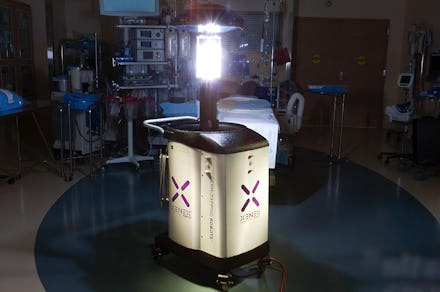Thousands get deadly infections during hospital care in the US. This robot could be the solution.

Hospitals are meant to help people get better, but they are not immune to some of the world’s most dangerous, disease-causing microorganisms. An estimated 75,000 people in the U.S. who contracted health care-associated infections died in 2011, according to the Centers for Disease Control and Prevention, and about 722,000 cases of such infections were recorded that year.
Now, a bright and shiny robot may catch on as the world’s new line of defense. The Xenex LightStrike, a germ-killing bot from San Antonio, has made its way into more than 400 hospitals and other facilities across Europe, Africa, Japan and the United States. A series of studies on hospitals using the robot show infection rates were reduced by 50% or more.
“The robot is able to go in after the traditional cleaning is taking place, so it’s not getting rid of any jobs,” Melinda Hart, a spokesperson for Xenex, said. “Then it goes in and uses blasts of UV light to go ahead and deactivate or kill anything in the room that can’t be seen.”
To use it, hospital staff members place the robot in different areas, tap its touch screen interface to turn it on, then leave the room for a few minutes. The robot opens up, reaching a height of just over five feet when activated, then shines intense xenon UV light into the room. Generally speaking, the robot is left in bathrooms for about five minutes and then on each side of a hospital bed for another five. Because of the light’s extreme brightness, staff members have to leave the room (otherwise, it’s sort of like looking at the sun for too long, according to Hart).
Part of the reason why dangerous infections spread in hospitals is because the tiny, disease-causing microorganisms such as Clostridium difficile can become resistant to antibiotics and common chemical cleaners. C. Diff causes serious colon inflammation that can lead to death, so anything that can kill it is probably going to be welcome in hospitals. The light-emitting robot could also be used in other facilities where infections are commonly spread, Hart said.
“If you think about locker rooms, they’re pretty germy. And so on football and wrestling teams, you’ll see MRSA outbreaks,” she said. “We’ll go to schools and disinfect them for free to educate.”
The robot costs $125,000, but that’s not so steep considering that health care-associated infections directly cost U.S. hospitals an estimated $28 to $45 billion a year, according to a 2009 study. Rolling one around hospital floors might save millions of dollars, but better yet, it might be able to save millions of lives, too.